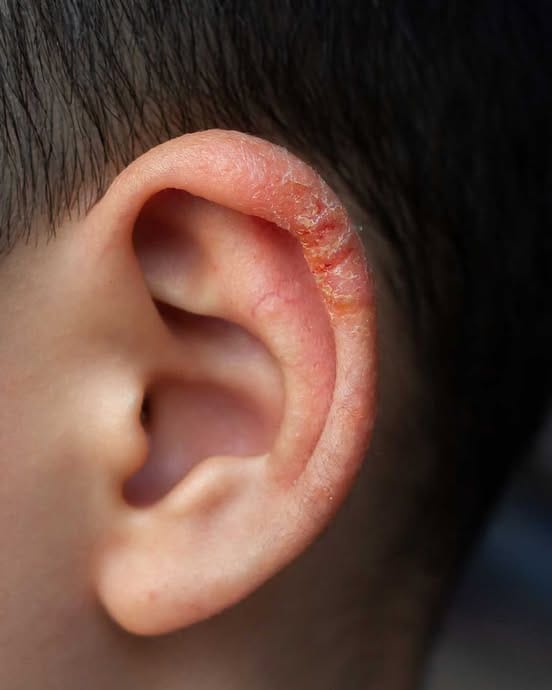Discovering an unusual skin condition on your child’s ear can be distressing, particularly when a doctor’s appointment is not readily accessible. Parents frequently express concerns regarding the underlying cause, possible discomfort, and the necessity for immediate intervention. This article seeks to offer advice on the appropriate measures to take while awaiting a medical consultation, thereby assisting you in managing the situation effectively and alleviating anxiety.
Understanding Atopic Dermatitis: A Common Skin Condition
Atopic dermatitis, often referred to as eczema, is a widespread skin condition that affects numerous children. It is marked by inflamed, itchy, and at times scaly patches of skin. Although it can manifest anywhere on the body, the ears are particularly susceptible due to their exposure to environmental elements and frequent contact with irritants. Gaining insight into this condition can aid in determining whether it may be responsible for the unusual skin appearance on your child’s ear.
Identifying Symptoms: What to Look for in Inflamed Skin
When assessing your child’s ear, be vigilant for key symptoms such as redness, swelling, dryness, or a rash. The skin may exhibit thickening or small bumps. Itching is a prevalent symptom that can lead to scratching, potentially exacerbating the condition. Pay attention to any discharge or crusting, as these may signal an infection that necessitates prompt medical evaluation.
Immediate Steps to Take: Managing Discomfort at Home
To ease discomfort, ensure the affected area remains clean and dry. Utilize a mild cleanser and refrain from using harsh soaps that could worsen irritation. Applying a cool compress can provide relief from itching and diminish inflammation. Encourage your child to avoid scratching the area to prevent further irritation or the risk of infection.
Home Remedies and Over-the-Counter Solutions
Consider the application of over-the-counter hydrocortisone cream to alleviate inflammation and itching, but use it judiciously and in accordance with the package guidelines. Moisturizers or emollients can assist in maintaining skin hydration and forming a protective barrier. Natural remedies such as coconut oil or aloe vera gel may also be beneficial.
While awaiting your appointment, observe the skin for any indications of infection, such as heightened redness, warmth, discharge, or fever. Should these symptoms arise, it is imperative to contact your healthcare provider without delay, as they may necessitate immediate medical attention. Furthermore, if the condition deteriorates swiftly or results in considerable pain, seek medical guidance without hesitation.
Preparing for the Doctor’s Appointment: Key Discussion Points
To effectively prepare for your child’s medical appointment, document the onset and development of symptoms, any home remedies attempted, and their outcomes. Capture photographs of the affected area to illustrate changes over time. Be prepared to discuss your child’s medical history, including any allergies or prior skin conditions, to assist the physician in making an accurate diagnosis.
Preventive Strategies: Minimizing Future Flare-Ups
To avert future skin problems, it is essential to identify and steer clear of potential triggers such as harsh soaps, allergens, or extreme temperatures. Establish a consistent skincare regimen that incorporates gentle cleansing and moisturizing. Dress your child in breathable materials to lessen irritation, and keep their nails trimmed to minimize damage from scratching.
Conclusion: Remaining Informed and Proactive Regarding Skin Health
While noticing unusual skin on your child’s ear may be concerning, taking informed and proactive measures can facilitate effective management of the situation. By familiarizing yourself with common skin conditions, applying home care techniques, and preparing for medical consultations, you can ensure the maintenance of your child’s skin health. Stay alert and knowledgeable to decrease the chances of future issues and enhance overall well-being.
